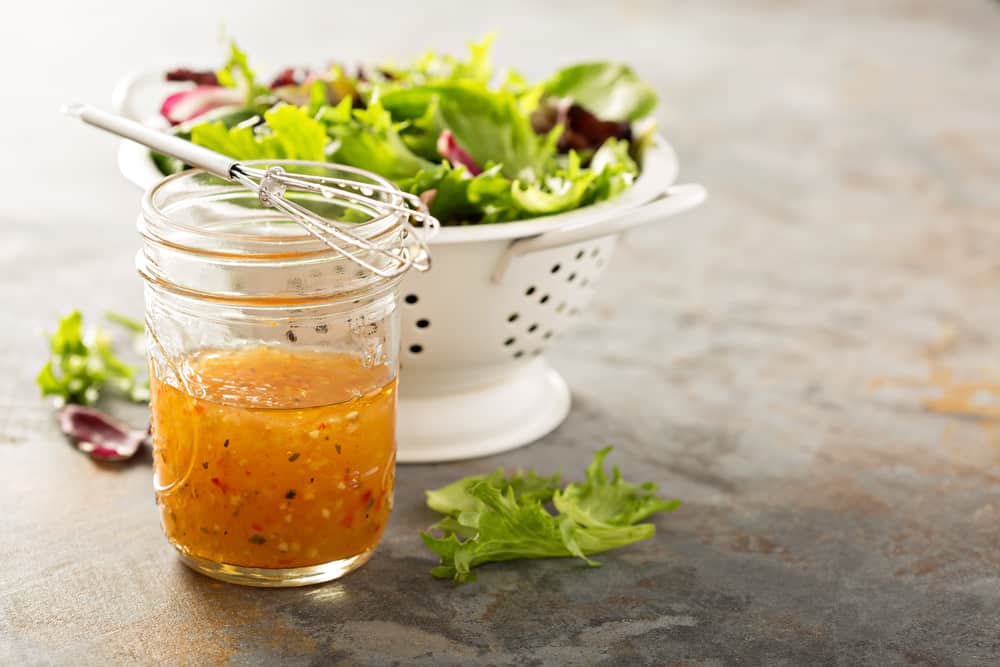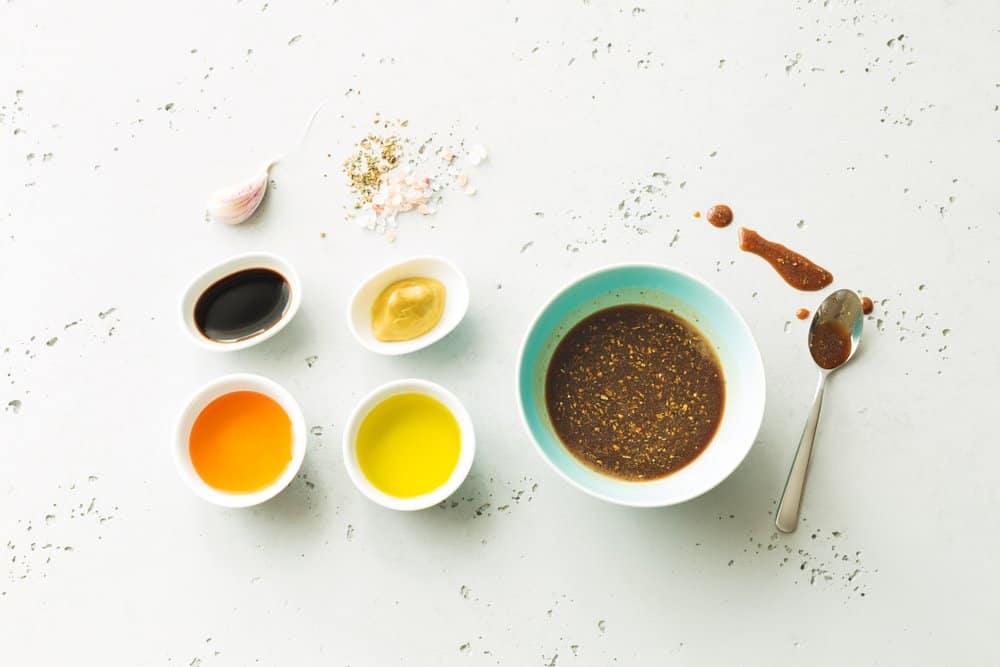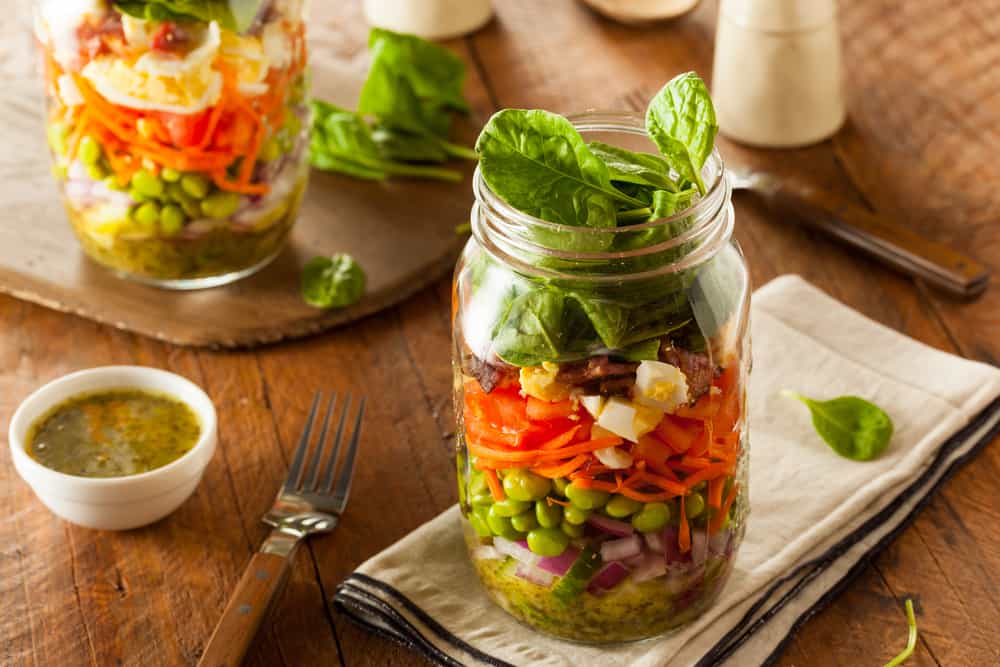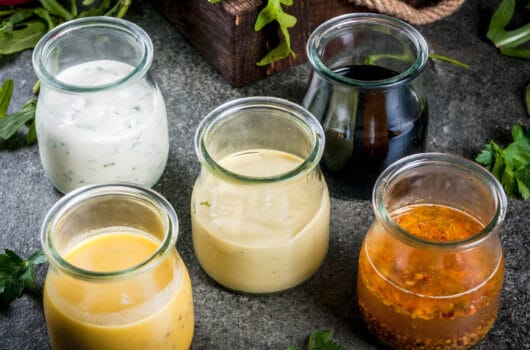Ah, the humble salad. While some people fall squarely into the anti-salad camp, the savvy among us know that salads can be delicious nutrient-packed feasts. When you’re pregnant, getting enough of the essential vitamins and minerals you and your baby need can be tough. Working a salad into your daily routine can go a long way to helping fill any gaps in your diet.
You may wonder, though, which dressings are safe? Most store-bought dressings are perfectly safe, but there are certain ingredients that can be dangerous for your unborn child, so it’s good to consider what’s in your dressing before you dig in.
Dressings to Avoid
Any dressing that includes uncooked ingredients can pose a danger to you and your baby. Eggs and dairy products that haven’t been brought up to a safe temperature can contain bacteria that may be harmful to a developing fetus.
Eggs should be cooked to at least 160ºF during pregnancy. At this point, both the white and the yolk will be firm. All dairy products should also be pasteurized before consumption. So raw milk and runny raw cheeses are a no-go.
Caesar Dressing
A Caesar salad can be a delicious and simple option. Some high-end Caesar dressings, however, are made with raw eggs. If you are getting fresh-made dressing from a restaurant or deli, you might want to skip the Caesar and try something else. Most Caesar dressings bought at the grocery store, on the other hand, tend to use pasteurized eggs, making them perfectly safe while pregnant.
When making Caesar salad dressing, raw egg is whisked together with oil and lemon juice to create a creamy dressing. While the acid from the lemon creates a sort of chemical change to the egg that is similar to the effect cooking has on it, it doesn’t remove all the potentially harmful bacteria.
Blue Cheese Dressing
This favorite dipping sauce for wings can also be delicious on a salad, especially when paired with sweet-tart flavors like dried cranberries. Like Caesar dressing, though, if it’s prepared fresh it can have some potential side-effects.
Blue cheese itself is often made with unpasteurized milk to help with the fermentation process. Raw cheeses like this can harbor Listeria, a foodborne illness that is much more likely to affect pregnant women. It can cause serious complications for your baby.
Even when made with pasteurized milk, any soft cheese has a higher risk of Listeria contamination. So brie, feta, and any wash-rind cheeses should stay off the menu. There are hard blue cheeses, though, to help you if the craving is really strong.
Raw Mayonnaise-Based Dressings
Freshly made mayonnaise or aioli is delicious and often considered far superior to commercial mayo. However, just like Caesar dressing, fresh mayonnaise is made with raw egg yolks whisked together with oil.
Many creamy homemade and fresh dressings at restaurants are made with mayonnaise as their base, so it’s important to check before ordering.
Commercially prepared mayonnaise is usually safe to consume during pregnancy, but try picking an olive oil mayo instead of the plain variety to reduce the amount of lower-quality fats in your diet.
Safe Salad Dressings

Most commercial dressing must be pasteurized. If a dressing is shelf-stable (meaning you buy it in the pantry section of the store, not the refrigerated section) it will most likely be safe.
However, for those creamy dressing that commonly include eggs and dairy, you may want to read over the ingredients ahead of time. Make sure the label states that the milk or cheese ingredients are pasteurized.
Refrigerated dressings are less of a safe bet, so you carefully check the ingredients. And, when in doubt, pick something different. You should also make sure that once a dressing is open, keep it refrigerated according to the label instructions and if it’s past its expiration date, toss it.
Vinaigrettes
Vinegar-based dressings are a delicious way to add some zip to your salad. They also are almost always perfectly safe, whether homemade or store-bought. Vinaigrette dressing combines different kinds of vinegar with oils and a variety of herbs and spices to create delicious flavors.
Some people will even just drizzle their favorite vinegar (balsamic and apple cider are two of the most flavorful options) over their salad directly with a pinch of salt and pepper. If you need something with a little less intensity, though, there are plenty of options that will compliment any salad.
Creamy Dressings
Sometimes you crave a touch of creaminess to balance out other acidic ingredients, or simply as a dip for your carrot sticks. Fortunately, many creamy dressings are safe. Some creamy dressings can be quite high in fat, which may make some expectant mothers shy away. The truth is that vinaigrettes can also have high levels of fat, but many lower-fat options do exist.
Ranch is typically a safe creamy option that is usually made with pasteurized buttermilk as the base. Low-fat options may use skim milk and add starch as a thickener. Pasteurized or even egg-free Caesar is also commercially available at most stores.
How to Make Your Own Pregnancy-Safe Homemade Dressing

Commercially produced salad dressing can be home to plenty of mystery ingredients. Preservatives, thickeners, artificial colors–it can be a headache to decipher all the peculiar terms on a label. The shorter and simpler an ingredients list is, the more likely a product will be more healthy and nutritious.
So, if bottled dressings have got you down, you can easily start making your own at home. You don’t need special equipment and you can customize the ingredients to use what you have on hand and whatever will complement your favorite salad.
For developing recipes, we’re recommending ratios rather than measurements. If you’re making dressing for a single salad, you might only need a few teaspoons of each ingredient, but if you’re making a bigger batch, you’ll need to increase those amounts. The term “one part” used here refers to whatever your base measurement is. It could be one tablespoon or even one cup, depending on your batch size
Once you get to the seasoning part of developing your dressing, you should start with a little and taste frequently as you slowly increase the amount. You can always add more spices, but it’s a lot harder to take some out.
You can whisk your dressing together in any bowl, or you can make it directly in a jar or container for storage. If you make it in a jar, you don’t have to worry about whisking. Just make sure the lid is on tight then shake it to combine. Spoon it over your salad and enjoy!
Choosing a Vinegar Base
The simplest kind of dressing to start with is a vinaigrette. Most of us have vinegar and oil already in our kitchen, though the harsh white vinegar you might use for cleaning isn’t the tastiest option.
Picking a fermented vinegar like balsamic, red wine, or apple cider vinegar tends to give you better flavor. Even a rice wine vinegar can be a good base if you’re going for more Asian flavor inspirations in your salad.
Keep in mind that raw vinegar should be avoided during pregnancy. Pasteurized apple cider vinegar will still give you great flavor if that’s your vinegar of choice.
Whichever vinegar you choose, this will be the base of your dressing. A good starter ratio is about 3 parts vinegar to two parts oil (though some recipes may reverse that ratio depending on other add-ins).
Choosing an Oil
Oils are rich in fat. You don’t want to overdo it on fats during pregnancy, but some healthy fats are essential to a balanced diet. Especially when you’re eating a meal that’s mainly made up of greens, adding fats will help you stay fuller longer as you digest all those nutrients.
Store-bought dressings often use cheap soybean oil as the base. When making it at home, however, you have the freedom to choose more healthful oils like extra virgin olive oil, avocado, or sesame oil.
Choose an oil that complements the flavor of your vinegar, or one with a lighter, more neutral taste to go with anything (like grapeseed or canola oil).
Add Flavor Depth
Sometimes when you just throw oil, vinegar, and a few spices together, the result can lack excitement and leave you wondering where you went wrong. The trick to getting flavors like you find in restaurant dressing is to add some depth.
Most dressings need a touch of sweetness to balance out the sour intensity of the vinegar. Just a little bit will help without making the dressing itself become sweet. While commercial dressings can be loaded with high-fructose corn syrup and white sugar, you can choose healthier options with more flavor.
Honey is a delicious and healthful sweetener that adds its own unique flavor. Maple syrup adds a complex sweetness and can have a lot of impact, even in small amounts. A raw or turbinado sugar can be used as well. The coarse, chunky sugar has a molasses flavor and fewer grams of sugar per tablespoon than white sugar.
Adding mustard is also a great way to develop more flavor. Dijon mustard has a savory and nutty taste that will work nicely with many vinaigrette dressings. Chunky whole-grain mustard adds a dynamic texture, but ground mustard is tasty as well.
Crushed or minced garlic can add a sharp, savory flavor. Garlic also has a ton of health benefits, particularly for pregnant women. Adding a bit of grated parmesan or another hard cheese can also add a salty, nutty bite that elevates the flavor, particularly in Italian dressings.
Herbs And Spices
Once your dressing is blended, you need to season it. Adding a hint of salt will help enhance the flavors, but don’t go overboard. Black pepper, especially freshly ground, can add a warm bit of spice.
But really, the only limit is your imagination. Even classic baking spices like cinnamon and nutmeg can be a great addition to your dressing.
Dried herb blends and seasoning mixes that you use in cooking can be mixed into your salad dressing. Fresh herbs can also be chopped up and blended in for a lighter taste. Dice them up finely to help them integrate into the dressing better.
Make a Creamy Dressing
If you’re getting tired of vinaigrette dressings, homemade creamy dressings are easy to make. Instead of using oil and vinegar for the body of the dressing, choose a plain Greek yogurt for a yummy protein-rich base. This is a healthy alternative to mayonnaise-based dressings that offers a lot more nutrients for the calories.
You may need to add a little water to the yogurt to thin it to your desired texture. Adding some citrus, like fresh lemon juice, is a great way to brighten up a yogurt dressing. You can also add in your choice of seasoning, with fresh herbs being especially nice in a creamy dressing.
Recipes to Try
If you’re having a hard time coming up with tasty salad toppers, you can always start with someone else’s recipe to get you started. Once you have the victory of creating your first delicious dressing, you can start to feel a little bolder about playing with your own unique combinations.
Your favorite food bloggers and food magazines probably have some recipes to tempt you, but here are a few sites to get you started.
- Wholefully has a list of 8 delicious and healthy dressing ranging from spicy southwest flavors to cool homemade ranch.
- The Kitchn compiled 10 super fast and easy dressings that come together in minutes.
- Smitten Kitchen has a bevy of creative salad recipes that work as family meals and are all dressed simply and deliciously.
- Bless This Mess shares 9 recipes based on supermarket and restaurant favorites but designed for busy moms.
- Bon Appetit brings together 27 salad dressing recipes from their huge pool of culinary talent so you can satisfy your gourmet urges.
Get Your Salad On

Salads can bring a whole world of fresh, crunchy deliciousness to the table. Fortunately, most dressings are perfectly safe to enjoy throughout your pregnancy. The biggest risk comes when enjoying freshly prepared dressings at a restaurant, so whether you’re dining out or grabbing something to go, always check before ordering a salad dressing that can have raw egg or unpasteurized dairy.
Most bottled dressings will be safe since they go through a pasteurization process. If you want to have more control over what you’re feeding yourself and your unborn baby, though, we recommend trying some homemade dressings. Not only will you eliminate mystery chemicals and additives that hide inferior ingredients, but you might also just find that what you make is tastier than anything the comes from a bottle.
